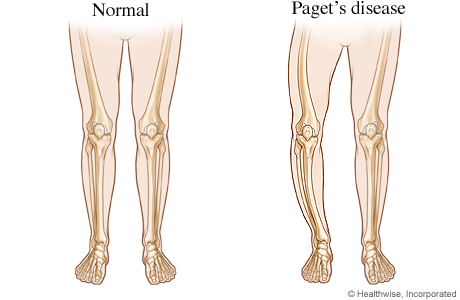Paget’s disease of bone is a chronic condition characterized by abnormal bone remodeling, leading to enlarged and weakened bones. Here’s an overview of its symptoms, causes, treatment, and prevention:
Symptoms:
- Bone Pain: Often in the affected bones, typically worse at night.
- Bone Deformities: Enlarged or misshapen bones, especially in the pelvis, skull, spine, or legs.
- Fractures: Weak bones may fracture more easily.
- Joint Pain: Paget’s disease can lead to osteoarthritis in affected joints.
- Nerve Compression: Enlarged bones can compress nearby nerves, leading to symptoms like tingling or numbness.
- Hearing Loss: If the skull is affected, hearing loss may occur.
Causes:
- Viral Infection: Some evidence suggests a viral infection (such as measles virus) early in life may trigger the disease in susceptible individuals.
- Genetic Factors: There appears to be a genetic component, as Paget’s disease tends to run in families.
- Age: The risk of developing Paget’s disease increases with age.
- Environmental Factors: Certain environmental factors, such as geographic location (more common in Europe than in Asia), may also play a role.
Treatment:
- Medications: Bisphosphonates, such as alendronate or risedronate, are commonly prescribed to slow bone turnover and reduce bone pain.
- Pain Management: Over-the-counter or prescription pain relievers may be used to manage bone pain.
- Physical Therapy: Exercises to improve strength, flexibility, and balance can help manage symptoms and reduce the risk of falls.
- Surgery: In some cases, surgery may be necessary to correct bone deformities, relieve nerve compression, or stabilize fractures.
Prevention:
- Early Diagnosis: Regular check-ups and screenings can help detect Paget’s disease early, allowing for prompt treatment.
- Healthy Lifestyle: Eating a balanced diet rich in calcium and vitamin D, as well as engaging in regular weight-bearing exercise, can help maintain bone health.
- Avoiding Smoking and Excessive Alcohol: Smoking and heavy alcohol consumption can increase the risk of Paget’s disease and worsen its symptoms.
- Monitoring: Regular monitoring by a healthcare professional can help track the progression of the disease and adjust treatment as needed.
While Paget’s disease of bone can be managed with treatment, there is currently no cure. However, with proper management, many people with Paget’s disease can lead active and fulfilling lives.































